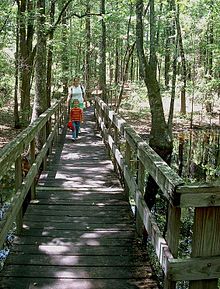
The Leon Sinks Geological Area is located on the Woodville Karst Plain in southern and southwestern Leon County, Florida, United States. It is a mature karstic area on the Upper Floridan Aquifer. It is one of the most extensive underwater cave systems in the world and connects to Wakulla Springs.
This hydrological system is extremely vulnerable to pollution because of the very high permeability of the carbonate aquifer. Extensive mapping and exploration of these caves has been done by the Woodville Karst Plain Project to understand the complex dynamics of the area and to understand the proper ecological approach to keeping this system clean.
The Leon Sinks are full of life, including the freshwater eel and rare crustaceans, including the Woodville Karst Plain crayfish and the swimming Florida cave isopod Remasellus parvus, that only exist in the Woodville Karst Plain.
Wakulla-Leon Sinks cave system
Wakulla cave consists of a dendritic network of conduits of which 12 miles (19 km) have been surveyed and mapped. The conduits are characterized as long tubes with diameter and depth being consistent (300 ft or 91 m depth); however, joining tubes can be divided by larger chambers of varying geometries. The largest conduit trends south from the spring/cave entrance for over 3.8 miles (6.1 km). Four secondary conduits, including Leon Sinks, intersect the main conduit. Most of these secondary conduits have been fully explored.
On Dec 15, 2007, the connection between the Wakulla cave system and Leon Sinks cave system was made by members of the Woodville Karst Plain Project to create the Wakulla-Leon Sinks Cave System. [1] This connection established the system as the longest underwater cave in the United States [2] and the sixth largest in the world at a total of 31.99 miles (51.48 km) of surveyed passages. [3]
Sinkholes
Many of the sinkholes in the Leon Sinks Geological Area are linked through underwater caves. The area includes both wet and dry sinkholes. [4]
Wet sinkholes

- Big Dismal – 100 foot drop to the water which drops another 100 feet underwater with a cave entrance at 80 feet down. [5]
- Black
- Duckweed
- Fisher Creek
- Hammock (aka Little Dismal)
- Lost Stream
- Magnolia
- Natural Bridge
Dry sinkholes
- Back
- Big Eight
- Cone
- Far
- Field
- Gopher Hole
- Johnson
- Palmetto
- Tiny
- Turner
Park and trails
The Leon Sinks offer three hiking trails to the different sinkholes in the park including an observation platform at Big Dismal Sink. The trails feature over 20 species of trees and 75 different plants along with wildlife ranging from Carolina chickadees to gopher tortoises. [4]
Trails:
- Sinkhole Trail – 3.1 miles
- Gumswamp Trail – 2.3 miles
- Crossover Trail – 0.5 miles
References
-
^ Kernagis DN, McKinlay C, Kincaid TR (2008).
"Dive Logistics of the Turner to Wakulla Cave Traverse". In: Brueggeman P, Pollock NW, eds. Diving for Science 2008. Proceedings of the
American Academy of Underwater Sciences 27th Symposium. Dauphin Island, AL: AAUS. Archived from the original on December 28, 2012. Retrieved April 22, 2009.
{{ cite journal}}: CS1 maint: unfit URL ( link) - ^ Bob Gulden (April 24, 2013). "US longest underwater caves". Geo2 Committee on Long and Deep Caves. National Speleological Society (NSS). Retrieved June 12, 2013.
- ^ Bob Gulden; Jim Coke (May 13, 2013). "World longest underwater caves". Geo2 Committee on Long and Deep Caves. NSS. Retrieved June 12, 2013.
- ^ a b "Leon Sinks Geological Area". Florida Department of Environmental Protection. Retrieved March 28, 2010.
- ^ Big Dismal Sink
External links
- Wakulla Karst Plains Project
- Leon Sinks Geological Area - official site at Apalachicola National Forest